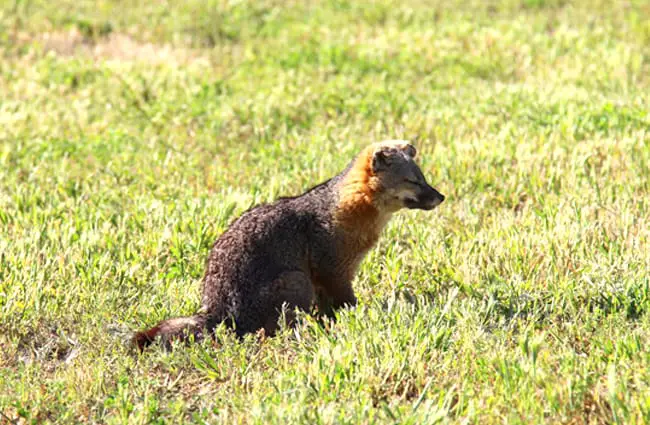A World Apart: Exploring the Enigmatic Island Fox
Imagine a creature perfectly sculpted by isolation, a miniature wolf thriving on islands kissed by the Pacific sun. This is the Island Fox, Urocyon littoralis, a remarkable canid whose story is one of evolutionary adaptation, near extinction, and triumphant recovery. These captivating animals, endemic to the Channel Islands off the coast of California, offer a unique window into the power of natural selection and the fragility of island ecosystems.

Island Fox Basics: Size, Appearance, and Habitat
The Island Fox is significantly smaller than its mainland cousin, the gray fox. Adults typically weigh between 3 and 6 pounds and measure 18 to 24 inches in length, including the tail. Their coat color varies depending on the island they inhabit, ranging from dark brown to reddish gray, offering effective camouflage within their diverse habitats. Each of the six Channel Islands supports a distinct subspecies, exhibiting subtle differences in size, coat color, and skull morphology.
These foxes are found exclusively on the Channel Islands of California: Santa Catalina, Santa Cruz, San Miguel, Santa Rosa, San Nicolas, and Anacapa. Their habitats are remarkably diverse, encompassing chaparral, woodland, grassland, and even coastal scrub. They demonstrate adaptability, utilizing caves, rock crevices, and dense vegetation for shelter and denning.
Where to Find Island Foxes in the Wild
For aspiring wildlife observers, spotting an Island Fox requires patience and respect. The best locations are the Channel Islands, accessible by boat or plane. San Miguel Island generally offers the highest density, while Santa Catalina Island supports a more visible population due to its popularity with tourists. Early morning or late evening are prime viewing times, as foxes are most active during these cooler hours. Remember to maintain a safe distance and never approach or feed these wild animals.
Evolutionary History: A Tale of Island Isolation
The Island Fox’s story began approximately 16,000 years ago, during the Pleistocene epoch. As sea levels rose, mainland gray foxes became stranded on the Channel Islands. Cut off from the mainland population, these ancestral foxes underwent allopatric speciation, evolving into distinct subspecies due to the unique environmental pressures on each island. This isolation led to a phenomenon known as “island dwarfism,” where animals tend to become smaller over generations. The limited resources and lack of large predators favored smaller individuals, resulting in the petite Island Fox we know today.

Diet and Hunting Strategies
The Island Fox is an opportunistic omnivore, with a diet heavily influenced by seasonal availability. Their primary food sources include deer mice, ground squirrels, insects, fruits, berries, and plants. They are skilled hunters, employing a stealthy approach to prey. Their excellent hearing and keen sense of smell enable them to locate prey hidden beneath vegetation or within burrows. They also cache food, burying surplus items for later consumption. This behavior is particularly important during times of scarcity.
Reproduction and Family Life
Island Foxes are typically monogamous, forming long-term pair bonds. Breeding season occurs from March to April. Gestation lasts approximately 53 days, resulting in litters of 2 to 5 kits. Kits are born blind and helpless, relying entirely on their parents for care. They are weaned at around 8 weeks and begin to explore their surroundings under the watchful eye of their parents. Young foxes typically disperse from their natal territory in the fall, seeking to establish their own territories.

Ecological Role and Interactions
As a mesopredator, the Island Fox plays a crucial role in regulating populations of rodents and other small animals. This helps maintain the health and balance of the island ecosystems. They also contribute to seed dispersal through their consumption of fruits and berries. Island Foxes coexist with a variety of other animals, including the island scrub jay, California quail, and various reptile species. They have historically faced limited predation from bald eagles and golden eagles, but these interactions are relatively infrequent.
A Near Extinction and Remarkable Recovery
In the late 1990s, the Island Fox population plummeted due to a devastating outbreak of canine distemper virus and predation by golden eagles. The eagles, experiencing a population boom due to the decline of the native California sea lion, began to prey heavily on the naive and unvaccinated foxes. By 1998, the total population had dwindled to a mere 150 individuals.
A collaborative effort involving the National Park Service, The Nature Conservancy, and the California Department of Fish and Wildlife initiated a comprehensive recovery program. This included captive breeding, vaccination campaigns, and the removal of golden eagles. The program proved remarkably successful. As of 2019, the Island Fox population has rebounded to over 5,000 individuals, and the species was removed from the endangered species list. This stands as a powerful example of effective conservation in action.

Island Foxes and Humans: A History of Interaction
Native American populations, such as the Chumash, historically utilized Island Foxes for their pelts and meat. However, their impact on the fox population was likely minimal due to sustainable harvesting practices. With the arrival of European settlers, hunting and habitat destruction became significant threats. In recent decades, human activities have focused on conservation efforts, with a growing emphasis on responsible tourism and habitat protection.
Island Fox Care in Captivity: A Zookeeper’s Guide
Caring for Island Foxes in captivity requires a deep understanding of their natural history and specific needs. Their enclosure should mimic their native habitat, providing ample space, varied terrain, and enrichment opportunities. Diet should consist of a balanced mix of commercially available canine food, supplemented with fruits, vegetables, and meat. Regular veterinary care is essential, including vaccinations and parasite control. Socialization is also important, as Island Foxes are naturally social animals. Zookeepers should strive to create a stimulating and enriching environment that promotes the physical and psychological well-being of these remarkable creatures.
Intriguing Island Fox Facts
- Island Foxes are capable of swimming, and will occasionally venture into the ocean to forage for food or reach other islands.
- They have a unique scent marking behavior, using urine and feces to establish territories and communicate with other foxes.
- Their large ears are not just for show; they enhance their hearing, allowing them to detect even the faintest sounds of prey.
- Each island subspecies exhibits slight variations in skull morphology, reflecting their adaptation to local resources.
- Island Foxes play a crucial role in controlling insect populations, helping to maintain the health of island ecosystems.

Conclusion: A Symbol of Resilience
The Island Fox is more than just a beautiful and intriguing animal; it is a symbol of resilience, adaptation, and the power of conservation. Its story serves as a reminder that even the most vulnerable species can recover with dedicated effort and collaborative action. As we continue to face unprecedented environmental challenges, the Island Fox offers a beacon of hope and a testament to the importance of protecting our planet’s biodiversity.

![Red Angus Closeup of a beautiful Red Angus cowPhoto by: U.S. Department of Agriculture [pubic domain]https://creativecommons.org/licenses/by/2.0/](https://animals.net/wp-content/uploads/2020/03/Red-Angus-4-238x178.jpg)




![Red Angus Closeup of a beautiful Red Angus cowPhoto by: U.S. Department of Agriculture [pubic domain]https://creativecommons.org/licenses/by/2.0/](https://animals.net/wp-content/uploads/2020/03/Red-Angus-4-100x75.jpg)

